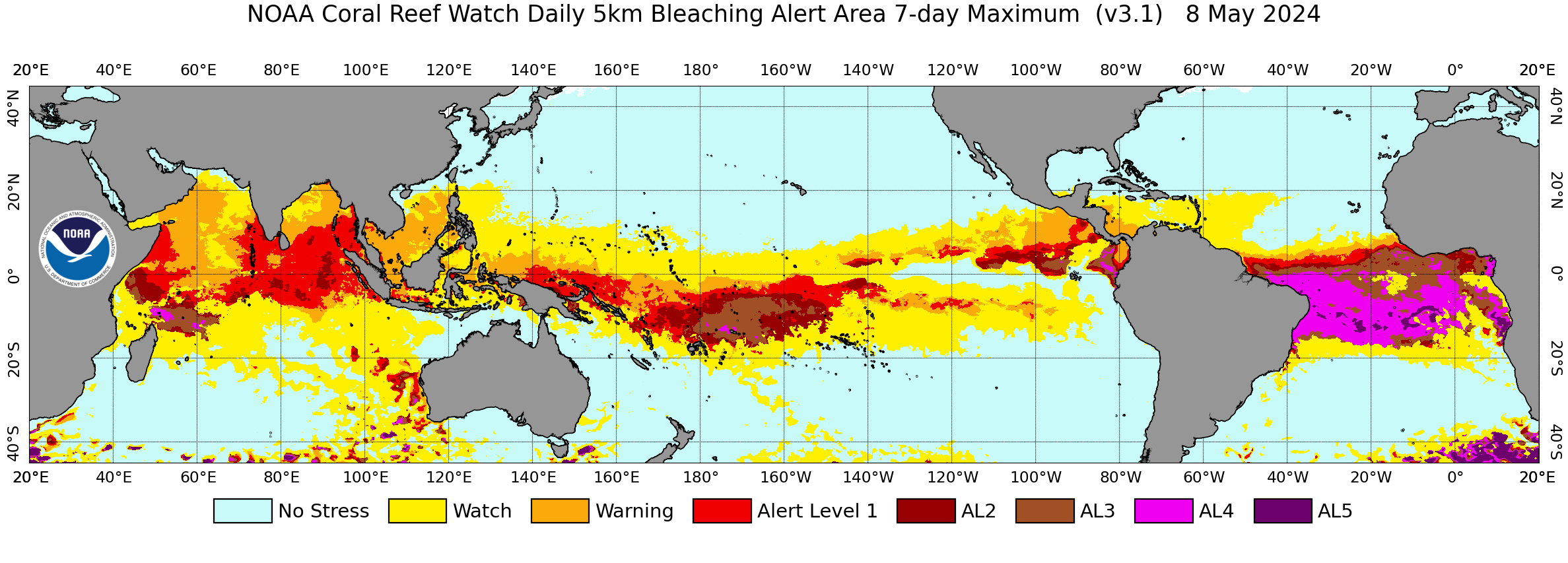
The NOAA Coral Reef Watch (CRW) daily global 5km satellite Bleaching Alert Area (7-day maximum) product presented here outlines the areas where coral bleaching heat stress currently reaches various levels, based on our satellite sea surface temperature (SST) monitoring.
SST variability is often considerably higher at the much finer 5km spatial and daily temporal resolutions, when compared with CRW's heritage twice-weekly 50km (0.5-degree) coral bleaching heat stress monitoring products. Due to resulting day-to-day fluctuations between stress levels in highly-variable locations, the single-day 5km Bleaching Alert Area product does not consistently and adequately identify potentially harmful heat stress levels, especially with regard to accumulated heat stress impacts. Rather than requiring users to examine the single-day 5km Bleaching Alert Area product over several days, a 7-day maximum Bleaching Alert Area composite product, updated daily, was introduced in the Version 2 product suite and is maintained here in Version 3.1. (Evolution of CRW's daily global 5km product suites can be found here.) This 7-day composite product shows the maximum stress level that a satellite pixel has experienced during the most recent seven (7) consecutive days. Data and images are dated on the last day of the 7-day period. Notably, it is compatible with CRW's heritage twice-weekly global 50km Bleaching Alert Area product, as the 50km Bleaching Alert Area is based on a half-week (3 or 4 days) composite of 50km SSTs (but with much less SST variability due to its much coarser spatial resolution).
Even though the daily global 5km Bleaching Alert Area (7-day maximum) composite product is presented here, the coral bleaching heat stress levels defined in the table below are for the daily global single-day 5km Bleaching Alert Area product. The heat stress level at a 5km satellite data grid, on any day, is based on CRW's daily global 5km Coral Bleaching HotSpot and Degree Heating Week (DHW) products for that day. The daily global 5km Bleaching Alert Area (7-day maximum) composite product therefore is the maximum value of the seven, consecutive, daily global single-day 5km Bleaching Alert Area values in the data grid that end on the date shown in the image.
***UPDATE: On December 15, 2023, NOAA Coral Reef Watch implemented a revised coral bleaching heat stress category system for its Bleaching Alert Area product. Extreme accumulations of coral bleaching heat stress in 2023, in multiple regions of the world, especially in the eastern tropical Pacific Ocean and Greater Caribbean, which were confirmed by in-water observations, necessitated the introduction of additional Bleaching Alert Levels. This development is a refinement of the original system that only used Bleaching Alert Levels 1 and 2. The new Alert Levels 3-5 provide important, added detail, for when the magnitude of extreme heat stress exceeds the threshold of Alert Level 2 conditions. For managers: we understand that coral bleaching response plans, action plans, and restoration plans around the world rely on NOAA Coral Reef Watch's Bleaching Alert Levels, to assist with planning and implementation of work by your in-water monitoring and management networks. Any actions you would have taken at Bleaching Alert Level 2, previously, still apply. We recognize, however, that discussions may need to occur now, regarding appropriate actions for your networks, when the extreme Bleaching Alert Levels 3-5 are predicted.***
Note that in the Bleaching Alert Area (7-Day Maximum) composite product, locations with a status of No Stress or Bleaching Watch, for a 7-day time period, may still have been exposed to recent heat stress, including in the days immediately preceding the 7-day period under evaluation. The reason is that the Bleaching Alert Area (7-Day Maximum) composite product classifies the heat stress condition for a specified 7-day period only -- and that heat stress condition (level) is determined by the seven, most-recent daily value pairs of CRW's v3.1 daily global 5km Coral Bleaching HotSpot and DHW. So if, during the specified 7-day period being evaluated, the seven Coral Bleaching HotSpot values (within the seven daily pairs of Coral Bleaching HotSpot/DHW) were all zero, this would indicate the absence of active heat stress. For that reason, a No Stress level would be assigned, and any heat stress experienced during the 11 weeks preceding the 7-day period would not be examined, as corals should be in a recovery state. If, during the specified 7-day period being evaluated, any of the seven Coral Bleaching HotSpot values (within the seven daily Coral Bleaching HotSpot/DHW pairs) was greater than zero, but below the bleaching threshold for accumulating DHWs, this would indicate that there is currently insufficient heat stress to actively cause or worsen visible bleaching. For this reason, none of the seven daily DHW values (within the seven daily Coral Bleaching HotSpot/DHW pairs) would be examined; a Bleaching Watch level would be assigned; and any recently-accumulated DHWs greater than zero, that occurred within the 11 weeks preceding the 7-day period, would not be used to determine the current heat stress level. With that said, if on any future day, the Coral Bleaching HotSpots resurrected, and were greater than the threshold for accumulating DHWs, then recent heat stress exposure during the entire past 12 weeks (84 days) would be evaluated. This means all daily Coral Bleaching HotSpot values that exceeded the bleaching threshold during the past 12 weeks would be accumulated to calculate the DHWs and determine the Bleaching Alert Area (7-Day Maximum) composite product heat stress level. As a result, a future heat stress level could jump from No Stress or Bleaching Watch to any of the higher stress levels, as the calculation would again be dependent on recent heat stress exposure during the entire last 12 weeks. Please refer to CRW's daily global 5km DHW product for more information.